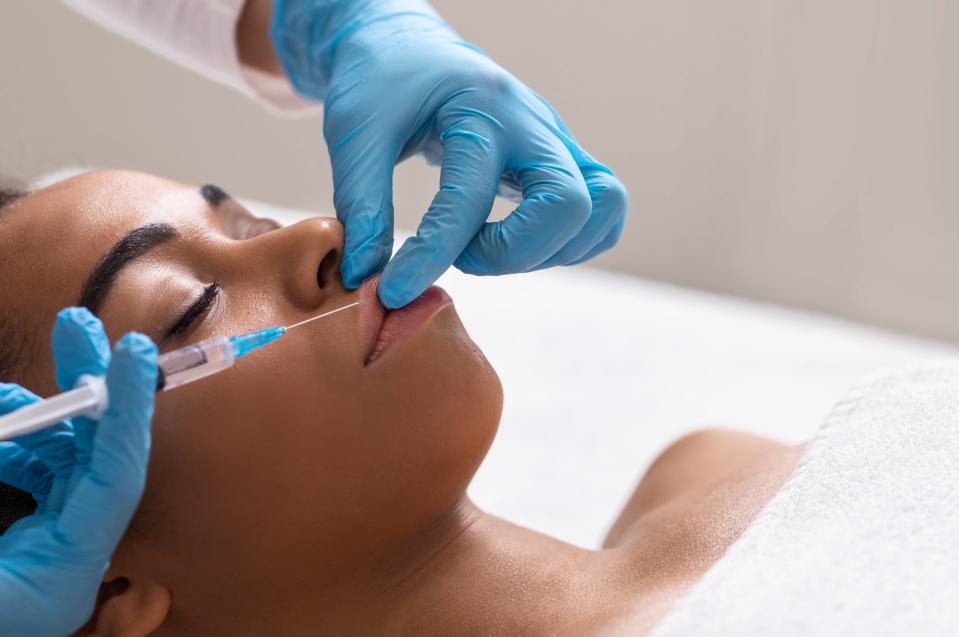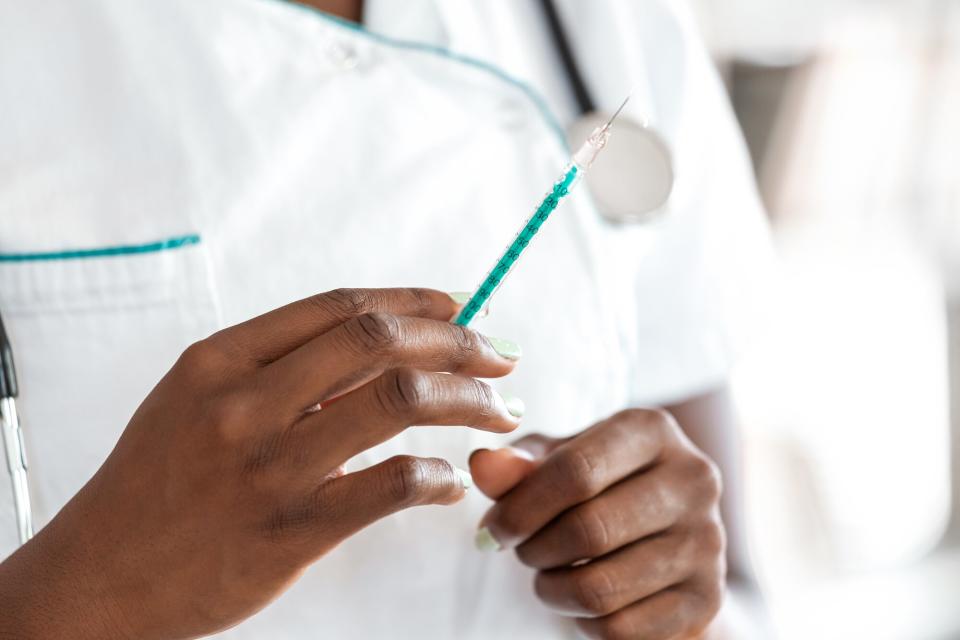Which Anti-Aging Treatments Are Actually Available for Women of Color?

Hearing phrases like "Black don't crack" and "Asian don't raisin" can easily lead one to believe that anti-aging treatments aren't a high priority for women of color.
While this is partly true, especially for Black women, things are starting to shift across the board.
According to InStyle's Transformative Beauty study, the idea of getting, or even talking about, certain cosmetic enhancements is still especially taboo in some communities of color, however, more of these women are open to getting treatments done. In fact, 69% of Hispanic, 72% of African American, and 60% of Asian women reported getting a non-surgical body procedures in the past two years.
But they're being influenced by celebrities who don't necessarily look like them — meaning that results could vary significantly, or the treatment may not be an option for them at all.
African American women from age 31 to 49 shared that they keep up with women like Heather Dubrow, Kylie Jenner and the other Kardashian sisters, plus the cast of the various Real Housewives franchises to stay apprised on the latest skincare products or in-office treatments. And while Hispanic women are more likely to get treatments later in life — typically in their early to mid 40s — once they get there, they're open to procedures like sclerotherapy to diminish the look of veins as well as various laser procedures to get rid of concerns like hyperpigmentation. Asian and Pacific Islanders tend to start going in-office earlier, and gravitate more towards IPL, laser hair removal, and other laser treatments.
However, while some women of color are open to getting work done, we can't overlook the fact that there are certain racial disparities in the dermatology field. Aside from the lack of training in medical school when it comes to treating skin of color, several treatment options, like lasers, weren't historically made with melanin in mind.
Things are starting to turn around, however. But there are still several factors women of color need to keep in mind when seeking out cosmetic treatment, including what's actually safe to do and the best doctors to go to.

ProStock Studio/Getty Images
Which anti-aging treatments are actually safe for skin of color?
According to Dr. Elyse Love, traditional laser treatments were long thought of as unsafe for skin of color, however over the past few years there's been a shift.
Both Fraxel and Clear and Brilliant are among her most trusted anti-aging treatments for patients of color. However, she stresses that what's most important is that the dermatologist performing the procedure knows how to work with darker skin tones.
"Fraxel can be performed on skin of color, but there are specific adjustments to the treatment settings that should be performed," she explains. "Those with skin of color looking to undergo Fraxel should seek out skin of color experts who practice the procedure."
Otherwise, the treatment could potentially exacerbate your primary concerns.
"One Fraxel treatment can deliver more dramatic reversal of fine lines, wrinkles, and sun spots than multiple Clear and Brilliant treatments, but there is more downtime and a significantly higher risk of post-inflammatory hyperpigmentation," Dr. Love shares.
"Reading skin of color requires significant experience."
—Dr. Michelle henry
With Clear and Brilliant, on the other hand, results takes longer, but the treatment is thought to be a lot less risky.
"This laser is often referred to as 'baby Fraxel' because it has the same wavelengths as Fraxel, but the settings are much lower," Dr. Love explains. "This allows the procedure to be safe in all skin types and with little to no downtime. I consider Clear and Brilliant to be more of a preventative treatment than Fraxel, and it's an excellent option for those in their late 20s to 40s to delay the appearance of fine lines and wrinkles and to improve skin texture and tone."
Aerolase lasers are also a safe and effective option for skin of color, according to Dr. Michelle Henry.
The derm adds that she typically recommends patients do a series of six treatments a year, four weeks apart for best results.
"It is great for acne, laser hair removal, and pore minimalization," she shares. These lasers also tackle a number of other skin issues, like melasma, scars, and psoriasis.
Which treatments should women of color avoid?
While our study found many Asian and Pacific Islander women to be interested in IPL, Dr. Love warns that this is a treatment to be very careful with.
"IPL is the one laser that I would practice extreme caution as a woman of color," she says. "The target of the laser is not as specific as other lasers, so there is a much higher risk of burn in patients of color."
Dr. Henry cautions against aggressive resurfacing lasers, like CO2, as well, which are generally effective but can pose a serious risk for skin of color.
In-office treatments aside, she also says to be careful when using certain skincare ingredients at home.
"We should be careful with ingredients like benzoyl peroxide, which may irritate skin of color more readily," Dr. Henry explains. "But we can mitigate this with liberal moisturizer use."
How to pick the right doctor
If you're a woman of color, the sad truth is that you can't go to just any dermatologist when you're looking into getting cosmetic procedures.
"Reading skin of color requires significant experience," says Dr. Henry. "Understanding laser and aesthetic procedures on skin of color is an advanced skill."

SDI Productions/Getty Images
And while Dr. Henry and Dr. Love agree that you don't necessarily need to go to a Black, Asian, Hispanic, or any other MD of color, you do need to ensure that the dermatologist you see has significant experience working with darker skin tones, and is board certified.
"A person who is unfamiliar with treating your skin type has a greater risk of making one of two mistakes," Dr. Love shares. "Over-treatment, with the development of post-inflammatory hyperpigmentation and scarring, and under-treatment, with underwhelming results. I see this a lot with laser hair removal where my patients swear it didn't work for them, but see results [with me] almost immediately."
That said, if you feel most safe going to someone who looks like you, then you should do whatever is going to make you comfortable. You wouldn't take chances with any other major organ, so it's smart to think of your skin just as carefully.
"My patients will sometimes ask me, 'Have you done this on my skin tone before?' and I often giggle but I think it's a really important question to ask," Dr. Love continues. "As a dermatologist of color, I have learned how to treat skin of color on every device I use because patients of color seek me out and trust me. I also have almost every other Black dermatologist on speed dial to consult with if needed. With that being said, I do also refer my patients to colleagues who are not of color when I think they will give them the best result."
If laser treatments just aren't for you, consider injectables
While the "Botox stigma" is still prevalent in many communities of color, Botox, along with treatments like Dysport, Xeomin, and Jevea are all safe anti-aging alternatives.
"Since it is not a heat-based device, neuromodulators can be used safely in all skin types," explains Dr. Love. However, most patients of color can usually opt for filler instead, and still leave with similar results.

stefanamer/Getty Images
"Skin of color ages differently than lighter skin tones," she continues. "For this reason, many patients of color will come in for filler before Botox. Someone once told me 'Black don't crack, but it sags,' and it's true! After pigmentation, the most common concerns for my patients of color are heaviness in the lower face, deep nasolabial folds, and hollowing of the under-eye. These complaints can be effectively treated with dermal filler."
Now, if you find that those 'crack' and 'raisin' axioms aren't true, you'll know what to do for your skin — and which treatments simply won't be worth the effort.
This is the Glow Up, an examination of the most popular cosmetic procedures and products today, using survey data straight from readers like you.


